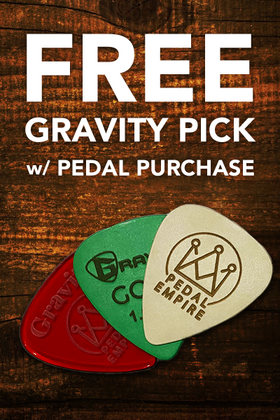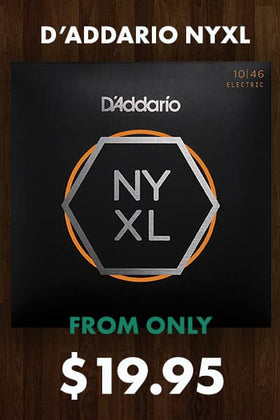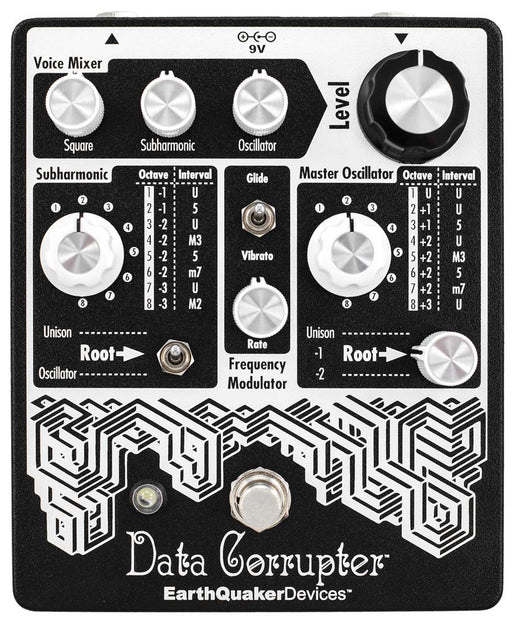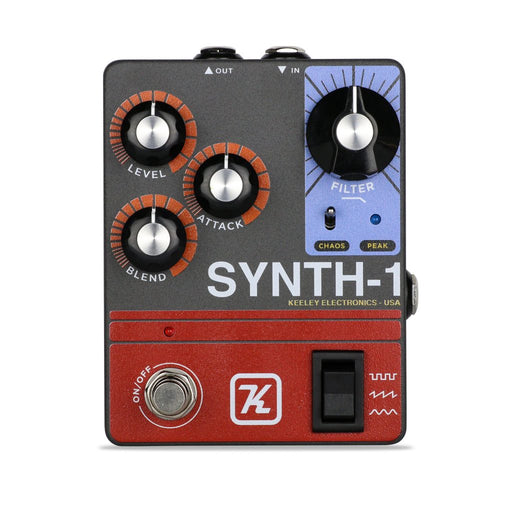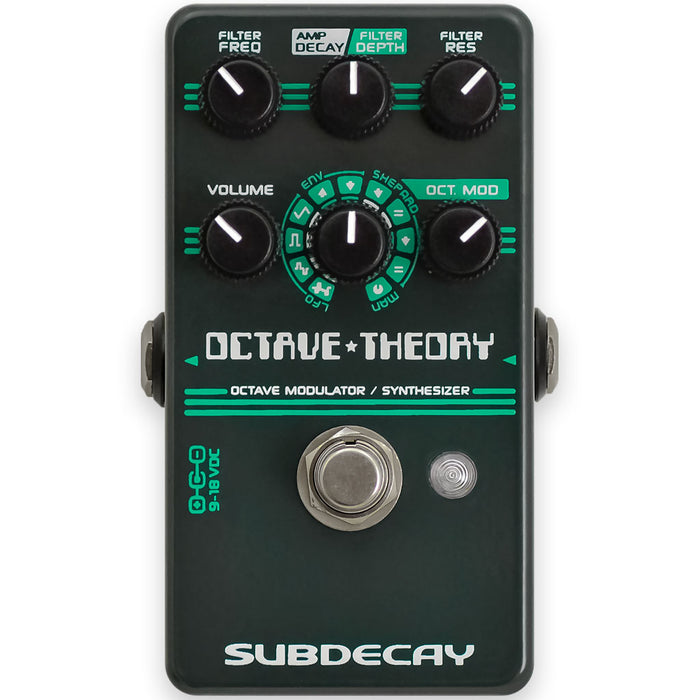

The first ever guitar synth with octave modulation
So what the heck is octave modulation? The octave theory seamlessly crossfades between octaves. Paired with an awesome filter this creates a multitude of possibilities. like 8 bit chiptune sounds, classic guitar synth, super sub bass tones and the world’s first ever shepard tone guitar synthesizer.
With great power…
An array of knobs covered many early 1980s synthesizers. This gave you the power to create a wide range of sounds. Of course, on some settings the synthesizer wouldn’t make a sound, would go into uncontrollable oscillation, or make weird noises. Sometimes the weird noises weren’t the weird noises you expected.
While many guitarists enjoy tweaking and honing their tone most of us don’t have that level of patience for fiddling with a matrix of interactive settings. The Octave Theory strikes the perfect balance giving you the power to create your own sound without endless knob tweaking or (gasp!) a tedious menu driven interface.
The Filter:
Resonant filter inspired by the Korg MS20. Like the MS20 the resonance knob can push the Octave Theory into oscillation. Most guitar synth pedals won’t let you go there. They think you can’t handle so much raw power. To be fair many of those filter oscillation sounds can get shrill or overbearing. If you keep the filter frequency low you can give your synth tones some growl. Use this power responsibly.
AMP vs. Filter priority and envelopes.
 ADSR envelopes are a mainstay of synthesizers. While lacking full external ADSR control an internal ADR (Attack/Decay/Release) envelope is generated to control the oscillator output level. (AMP – synthspeak for modulating the oscillator output level.)
ADSR envelopes are a mainstay of synthesizers. While lacking full external ADSR control an internal ADR (Attack/Decay/Release) envelope is generated to control the oscillator output level. (AMP – synthspeak for modulating the oscillator output level.)
AMP Priority (white marker): In modes with the white marker the decay knob gives you full control of the AMP decay. In these modes the filter also follows the ADR envelope at a fixed depth. This allows you to make notes decay quickly and gracefully. Turning the knob up allows for longer decay times.
Filter Priority (green marker): In green marker modes the filter follows an envelope generated by the strength of the input. (The same way envelope filters work) The depth knob controls how much influence the the input envelope has over the filter. When in filter priority the internal ADR envelope is fixed with infinite decay time.
Octave Modulation:
Modulate your octaves in four ways. LFO modulation, envelope modulation, shepard tone, or manual mode.
LFO: This is where you’ll find the chiptune sounds, especially with the square and double square wave modes.
In the triangle, square and double square modes the filter follows the internal ADR and the freq knob. In random Mode the filter follows the LFO. The octave mod knob controls the LFO speed.
Envelope: Playing dynamics modulate the octave cross fade. The octave mod knob controls the envelope’s overall influence.
Shepard Tone: As you work your way up the guitar neck playing higher notes, the octave cross fade descends. When set = modes playing one octave higher will produce the same note. You can play up the neck forever and arrive at the same pitch whether you are playing an open low E or the high E string on the twelfth fret. In ↓ modes the output pitch will get lower and lower as you play higher up the neck. In all shepard tone modes the oct. mod knob manually controls the octaves from several octaves down to several octaves up.
Manual mode: This is most similar to our original guitar synth pedal, the Octasynth, but with the most requested feature added. Instead of the Octasynth’s blend control which only allowed for one or two octaves down, the oct. mod knob takes you from three octaves down to two octaves up.
Warranty & Returns
All New products are covered by the manufacturers new warranty. Please check their website for the length of warranty and warranty conditions. If an item you receive is faulty get in touch with us ASAP. Second Hand products come with a 4 week warranty from us. If there is an issue let us know ASAP! This covers normal use and does not cover accidental damage, misuse, wrong power plugged into it, modding, water damage or any other damage caused by mistreatment. Just treat it nice and all will be good!
Shipping
We send A LOT of packages every week so don't worry about the shipping side of things!
We've never lost a thing and your awesome new gear will be packed up really well to avoid any damage in transit.
If your order comes in before 2pm we will ship it same day. Most of the time we pack things up all the way to 4pm so just call if you need it to leave same day after 2pm.
We ship mainly with Australia Post but may use a courier depending on location and size of the package.
Free Post ships with Australia Post standard and expected shipping times are between 4-6 business days depending on location. It will be longer to outside of metro and rural areas.
Express Post will usually be with you next business day in metro areas of QLD, NSW, SA, VIC and TAS. WA will take 2 days to metro and extra days after that to out side metro and rural areas.
Everything we ship has a tracking number with the exception of some power cables and smaller envelope packages. You will be emailed tracking once your order has been shipped!
The first ever guitar synth with octave modulation
So what the heck is octave modulation? The octave theory seamlessly crossfades between octaves. Paired with an awesome filter this creates a multitude of possibilities. like 8 bit chiptune sounds, classic guitar synth, super sub bass tones and the world’s first ever shepard tone guitar synthesizer.
With great power…
An array of knobs covered many early 1980s synthesizers. This gave you the power to create a wide range of sounds. Of course, on some settings the synthesizer wouldn’t make a sound, would go into uncontrollable oscillation, or make weird noises. Sometimes the weird noises weren’t the weird noises you expected.
While many guitarists enjoy tweaking and honing their tone most of us don’t have that level of patience for fiddling with a matrix of interactive settings. The Octave Theory strikes the perfect balance giving you the power to create your own sound without endless knob tweaking or (gasp!) a tedious menu driven interface.
The Filter:
Resonant filter inspired by the Korg MS20. Like the MS20 the resonance knob can push the Octave Theory into oscillation. Most guitar synth pedals won’t let you go there. They think you can’t handle so much raw power. To be fair many of those filter oscillation sounds can get shrill or overbearing. If you keep the filter frequency low you can give your synth tones some growl. Use this power responsibly.
AMP vs. Filter priority and envelopes.
 ADSR envelopes are a mainstay of synthesizers. While lacking full external ADSR control an internal ADR (Attack/Decay/Release) envelope is generated to control the oscillator output level. (AMP – synthspeak for modulating the oscillator output level.)
ADSR envelopes are a mainstay of synthesizers. While lacking full external ADSR control an internal ADR (Attack/Decay/Release) envelope is generated to control the oscillator output level. (AMP – synthspeak for modulating the oscillator output level.)
AMP Priority (white marker): In modes with the white marker the decay knob gives you full control of the AMP decay. In these modes the filter also follows the ADR envelope at a fixed depth. This allows you to make notes decay quickly and gracefully. Turning the knob up allows for longer decay times.
Filter Priority (green marker): In green marker modes the filter follows an envelope generated by the strength of the input. (The same way envelope filters work) The depth knob controls how much influence the the input envelope has over the filter. When in filter priority the internal ADR envelope is fixed with infinite decay time.
Octave Modulation:
Modulate your octaves in four ways. LFO modulation, envelope modulation, shepard tone, or manual mode.
LFO: This is where you’ll find the chiptune sounds, especially with the square and double square wave modes.
In the triangle, square and double square modes the filter follows the internal ADR and the freq knob. In random Mode the filter follows the LFO. The octave mod knob controls the LFO speed.
Envelope: Playing dynamics modulate the octave cross fade. The octave mod knob controls the envelope’s overall influence.
Shepard Tone: As you work your way up the guitar neck playing higher notes, the octave cross fade descends. When set = modes playing one octave higher will produce the same note. You can play up the neck forever and arrive at the same pitch whether you are playing an open low E or the high E string on the twelfth fret. In ↓ modes the output pitch will get lower and lower as you play higher up the neck. In all shepard tone modes the oct. mod knob manually controls the octaves from several octaves down to several octaves up.
Manual mode: This is most similar to our original guitar synth pedal, the Octasynth, but with the most requested feature added. Instead of the Octasynth’s blend control which only allowed for one or two octaves down, the oct. mod knob takes you from three octaves down to two octaves up.
Warranty & Returns
All New products are covered by the manufacturers new warranty. Please check their website for the length of warranty and warranty conditions. If an item you receive is faulty get in touch with us ASAP. Second Hand products come with a 4 week warranty from us. If there is an issue let us know ASAP! This covers normal use and does not cover accidental damage, misuse, wrong power plugged into it, modding, water damage or any other damage caused by mistreatment. Just treat it nice and all will be good!
Shipping
We send A LOT of packages every week so don't worry about the shipping side of things!
We've never lost a thing and your awesome new gear will be packed up really well to avoid any damage in transit.
If your order comes in before 2pm we will ship it same day. Most of the time we pack things up all the way to 4pm so just call if you need it to leave same day after 2pm.
We ship mainly with Australia Post but may use a courier depending on location and size of the package.
Free Post ships with Australia Post standard and expected shipping times are between 4-6 business days depending on location. It will be longer to outside of metro and rural areas.
Express Post will usually be with you next business day in metro areas of QLD, NSW, SA, VIC and TAS. WA will take 2 days to metro and extra days after that to out side metro and rural areas.
Everything we ship has a tracking number with the exception of some power cables and smaller envelope packages. You will be emailed tracking once your order has been shipped!

